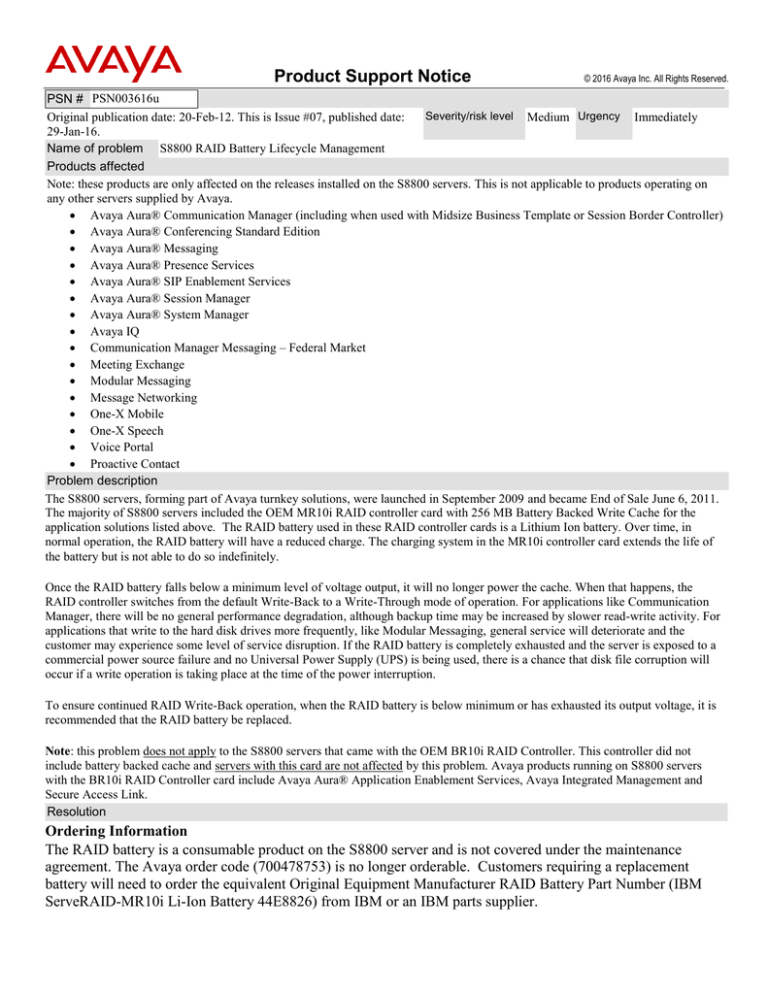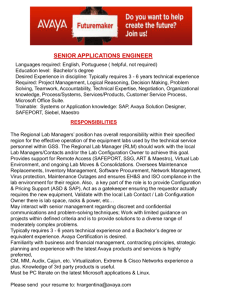
Product Support Notice
© 2016 Avaya Inc. All Rights Reserved.
PSN # PSN003616u
Severity/risk level Medium Urgency Immediately
Original publication date: 20-Feb-12. This is Issue #07, published date:
29-Jan-16.
Name of problem S8800 RAID Battery Lifecycle Management
Products affected
Note: these products are only affected on the releases installed on the S8800 servers. This is not applicable to products operating on
any other servers supplied by Avaya.
Avaya Aura® Communication Manager (including when used with Midsize Business Template or Session Border Controller)
Avaya Aura® Conferencing Standard Edition
Avaya Aura® Messaging
Avaya Aura® Presence Services
Avaya Aura® SIP Enablement Services
Avaya Aura® Session Manager
Avaya Aura® System Manager
Avaya IQ
Communication Manager Messaging – Federal Market
Meeting Exchange
Modular Messaging
Message Networking
One-X Mobile
One-X Speech
Voice Portal
Proactive Contact
Problem description
The S8800 servers, forming part of Avaya turnkey solutions, were launched in September 2009 and became End of Sale June 6, 2011.
The majority of S8800 servers included the OEM MR10i RAID controller card with 256 MB Battery Backed Write Cache for the
application solutions listed above. The RAID battery used in these RAID controller cards is a Lithium Ion battery. Over time, in
normal operation, the RAID battery will have a reduced charge. The charging system in the MR10i controller card extends the life of
the battery but is not able to do so indefinitely.
Once the RAID battery falls below a minimum level of voltage output, it will no longer power the cache. When that happens, the
RAID controller switches from the default Write-Back to a Write-Through mode of operation. For applications like Communication
Manager, there will be no general performance degradation, although backup time may be increased by slower read-write activity. For
applications that write to the hard disk drives more frequently, like Modular Messaging, general service will deteriorate and the
customer may experience some level of service disruption. If the RAID battery is completely exhausted and the server is exposed to a
commercial power source failure and no Universal Power Supply (UPS) is being used, there is a chance that disk file corruption will
occur if a write operation is taking place at the time of the power interruption.
To ensure continued RAID Write-Back operation, when the RAID battery is below minimum or has exhausted its output voltage, it is
recommended that the RAID battery be replaced.
Note: this problem does not apply to the S8800 servers that came with the OEM BR10i RAID Controller. This controller did not
include battery backed cache and servers with this card are not affected by this problem. Avaya products running on S8800 servers
with the BR10i RAID Controller card include Avaya Aura® Application Enablement Services, Avaya Integrated Management and
Secure Access Link.
Resolution
Ordering Information
The RAID battery is a consumable product on the S8800 server and is not covered under the maintenance
agreement. The Avaya order code (700478753) is no longer orderable. Customers requiring a replacement
battery will need to order the equivalent Original Equipment Manufacturer RAID Battery Part Number (IBM
ServeRAID-MR10i Li-Ion Battery 44E8826) from IBM or an IBM parts supplier.
Products Providing RAID Battery Alarm & Status
Some, but not all, applications have released service updates that provide alarming for the S8800 RAID Controller battery.
System Platform 6.0.3 and greater and 6.2.1 and greater have similar alarming. Note that System Platform includes support for the
Dell R610, which is not supported by CM 5.2.1.
The System Platform 6.0.3.6.3 patch:
System Platform provides improved system monitoring of RAID battery power levels. Write cache issues, the most common
issue, is monitored. Status on cache in Write-Through mode, battery backup weak and stuck in learn cycle which happens
on rare occasions, are monitored.
All applications running on System Platform benefit from this capability.
Please review the presentation “How To Check Status of S8800 RAID Battery on System Platform” available on the following
YouTube site, prepared by an Avaya associate.
http://www.youtube.com/watch?v=7qXbwRPzZ5E
Communication Manager 5.2.1 SP12 and greater provides alarming for low voltage RAID batteries and if the RAID Controller
cache is off. As explained in the Release Notes, which are available on Avaya Global Sales:
The S8800 and HP DL360 G7 servers used with Communication Manager 5.2.1 have RAID controllers with a cache back-up
battery. The battery is rechargeable but over time loses the ability to hold an adequate charge, causing the server to disable
caching and put the controller in write through mode. This can significantly slow down procedures such as software installs,
upgrades, or backup and restore that involve a lot of disk I/O. Slow I/O can also happen if caching is erroneously disabled on
the RAID controller. Communication Manager 5.2.1 Service Pack 12 introduces alarming for the RAID cache backup battery
condition and cache mode. A major alarm will be raised if the battery fails or the RAID controller is in write through mode.
Modular Messaging 5.2 SP 10 and above includes similar alarming for the RAID battery and Controller cache.
Session Manager 6.2 and above includes the ability to check the battery status using the hardware_info command.
S8800 MR10i RAID Battery Replacement Procedure
Replace the MR10i RAID Controller battery using the following procedure and paying attention to the cautions provided.
It is critical that you perform a graceful shutdown of the Application and server per the Application documentation.
Failure to comply with these procedures can have catastrophic effects on system hardware and service. Read the
explanations following the list to ensure a complete understanding of these necessary procedures.
For updated documentation, product support notices, and service pack information, go to the Avaya Support Center Web site at
http://support.avaya.com.
© 2016 Avaya Inc. All Rights Reserved.
Page 2
Remove Existing Battery
1. Shut down server according to AVAYA application procedures.
2.
Remove server from rack and place on even surface.
3.
Ensure Safe ESD practices.
4.
With server power off and AC line cord unplugged, open top latch of server and remove cover. Locate MR10I RAID
Controller and battery in front left of server.
5.
Disconnect the cable from the connector on the battery. Leave the other end of the cable connected to the battery carrier.
Battery carrier is mounted on top of MR10i RAID controller card.
6.
Remove battery from the battery carrier by depressing on top half of battery retaining clip, lift up and slide back. See figure
below.
7.
Dispose of removed battery properly.
Install New Battery
1. If replacement battery comes assembled to a battery carrier remove battery carrier by unplugging cable from battery. Set
battery carrier PWB aside.
2.
Connect server MR10i/battery carrier cable to connector of new replacement battery.
3.
Press the new battery onto the battery carrier of MR10i until the clip on the side of the battery snaps into place. See figure
above.
© 2016 Avaya Inc. All Rights Reserved.
Page 3
4.
Ensure battery is retained by clips.
5.
Place lid on server, reinstall in rack and power up.
8.
A battery learn cycle will start once the server powers up. The server will power up and function, but installation time of new
software could be slowed until a battery learn cycle completes (up to 6 hours).
Workaround or alternative remediation
n/a
Remarks
n/a
Patch Notes
The information in this section concerns the patch, if any, recommended in the Resolution above.
Backup before applying the patch
n/a
Download
n/a
Patch install instructions
n/a
Verification
n/a
Failure
n/a
Patch uninstall instructions
n/a
Service-interrupting?
Yes
Security Notes
The information in this section concerns the security risk, if any, represented by the topic of this PSN.
Security risks
n/a
Avaya Security Vulnerability Classification
Not Susceptible
Mitigation
n/a
If you require further information or assistance please contact your Authorized Service Provider, or visit
support.avaya.com. There you can access more product information, chat with an Agent, or open an online
Service Request. Support is provided per your warranty or service contract terms unless otherwise specified in the
Avaya support Terms of Use.
Disclaimer: ALL INFORMATION IS BELIEVED TO BE CORRECT AT THE TIME OF PUBLICATION AND IS PROVIDED “AS IS”.
AVAYA INC., ON BEHALF OF ITSELF AND ITS SUBSIDIARIES AND AFFILIATES (HEREINAFTER COLLECTIVELY REFERRED TO
AS “AVAYA”), DISCLAIMS ALL WARRANTIES, EITHER EXPRESS OR IMPLIED, INCLUDING THE WARRANTIES OF
MERCHANTABILITY AND FITNESS FOR A PARTICULAR PURPOSE AND FURTHERMORE, AVAYA MAKES NO REPRESENTATIONS
OR WARRANTIES THAT THE STEPS RECOMMENDED WILL ELIMINATE SECURITY OR VIRUS THREATS TO CUSTOMERS’
SYSTEMS. IN NO EVENT SHALL AVAYA BE LIABLE FOR ANY DAMAGES WHATSOEVER ARISING OUT OF OR IN CONNECTION
WITH THE INFORMATION OR RECOMMENDED ACTIONS PROVIDED HEREIN, INCLUDING DIRECT, INDIRECT, CONSEQUENTIAL
DAMAGES, LOSS OF BUSINESS PROFITS OR SPECIAL DAMAGES, EVEN IF AVAYA HAS BEEN ADVISED OF THE POSSIBILITY OF
SUCH DAMAGES.
THE INFORMATION PROVIDED HERE DOES NOT AFFECT THE SUPPORT AGREEMENTS IN PLACE FOR AVAYA PRODUCTS.
SUPPORT FOR AVAYA PRODUCTS CONTINUES TO BE EXECUTED AS PER EXISTING AGREEMENTS WITH AVAYA.
All trademarks identified by ® or TM are registered trademarks or trademarks, respectively, of Avaya Inc.
All other trademarks are the property of their respective owners.
© 2016 Avaya Inc. All Rights Reserved.
Page 4




